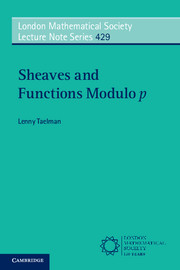Book contents
- Frontmatter
- Contents
- Introduction
- Chapter 1 τ-sheaves, crystals, and their trace functions
- Chapter 2 Functors between categories of crystals
- Chapter 3 The Woods Hole trace formula
- Chapter 4 Elementary applications
- Chapter 5 Crystals with coefficients
- Chapter 6 Cohomology of symmetric powers of curves
- Chapter 7 Trace formula for L-functions
- Chapter 8 Special values of L-functions
- Appendix A The trace formula for a transversal endomorphism
- Bibliography
- Index
Chapter 5 - Crystals with coefficients
Published online by Cambridge University Press: 05 November 2015
- Frontmatter
- Contents
- Introduction
- Chapter 1 τ-sheaves, crystals, and their trace functions
- Chapter 2 Functors between categories of crystals
- Chapter 3 The Woods Hole trace formula
- Chapter 4 Elementary applications
- Chapter 5 Crystals with coefficients
- Chapter 6 Cohomology of symmetric powers of curves
- Chapter 7 Trace formula for L-functions
- Chapter 8 Special values of L-functions
- Appendix A The trace formula for a transversal endomorphism
- Bibliography
- Index
Summary
Crystals with coefficients
τ-sheaves and crystals with coefficients
In this chapter C will always denote the spectrum of a commutative Fq-algebra A (on which we will impose various conditions). The C stands for coefficients. We will be considering objects on which the algebra A acts linearly.
algebra A acts linearly. Let X be a scheme over Fq. A τ-sheaf on X with coefficients in A is a pair ℱ = (ℱ, τ) consisting of a quasi-coherent OC×X-module ℱ and an OC×X-linear map
Morphisms are defined in the obvious way. We denote the category of such objects by QCohτ (X,A). By adjunction, specifying τ is equivalent to either giving an OC×X-linear map
or an additive map
τs : ℱ → ℱ
satisfying τs((a⊗r)s) = (a⊗rq)τs(s) for all a ∈ A and all local sections r and s of OX and ℱ respectively.
Now assume that C×X is noetherian. This is the case, for example, if X is noetherian and A of finite type over Fq. We say that a τ-sheaf on X with coefficients in A is coherent if the underlying OC×X-module is coherent. The category of such objects is denoted Cohτ (X,A).
An object ℱ = (ℱ, τ) in Cohτ (X,A) is said to be nilpotent if
is the zero map for some n > 0, or equivalently, if τns = 0 for some n > 0.
Proposition 5.1. Assume that C × X is noetherian. Let
0→ ℱ1→ ℱ2→F3→ 0
be a short exact sequence inCohτ (X,A). Then ℱ2is nilpotent if and only if both ℱ1and ℱ3are nilpotent.
Proof. The proof is identical to that of Proposition 1.17.
In other words, the full subcategory of nilpotent objects of Cohτ (X,A) is a thick subcategory. We define the category of A-crystals on X as the quotient category of Cohτ (X,A) by the thick subcategory of nilpotent objects. It is denoted Crys(X,A).
- Type
- Chapter
- Information
- Sheaves and Functions Modulo pLectures on the Woods Hole Trace Formula, pp. 63 - 70Publisher: Cambridge University PressPrint publication year: 2015

